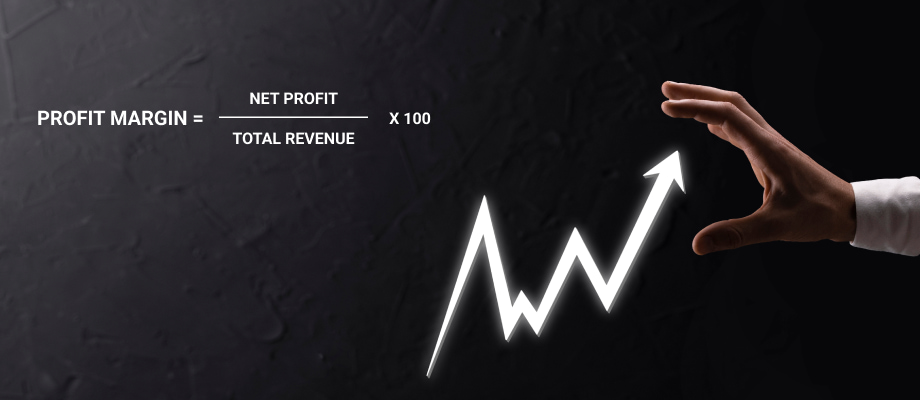Profit margin is critical in understanding a business’s financial health and performance. It is a key metric used by investors, analysts, and business owners to assess the profitability of an enterprise. Note that profit margins are the most widely used financial ratios in businesses due to their simplicity. So, what are profit margins, and how do they affect your business?
As an investor or business owner, it is crucial to be well-versed about this financial ratio. This means learning the margin of profit and how to calculate it so you can effectively understand your business’s profitability. Fortunately, we discuss everything here, giving you examples for better understanding.
What is Profit Margin?

As mentioned above, profit margin is a fundamental financial metric that plays a pivotal role in assessing a business’s profitability and financial health. It represents the percentage of revenue that remains as profit after deducting all expenses, providing insights into a company’s ability to generate profits from its operations. By analysing profit margins, businesses can evaluate their efficiency in managing costs, pricing strategies, and overall financial performance.
Profit margin serves as a key indicator for investors as well. It allows them to gauge a company’s profitability and potential returns before making investment decisions. A higher profit margin relative to competitors suggests better profitability and a stronger competitive position. However, it is essential to consider industry benchmarks and the company’s specific circumstances when evaluating profit margin. By understanding profit margin and its implications, both businesses and investors can make informed decisions to drive financial success.
How Profit Margin Works
Profit margin is a crucial metric businesses, and individuals worldwide use to evaluate the profitability and comparative performance of economic activities. While figures such as gross sales or earnings provide a glimpse into a business’s financials, they do not provide a comprehensive assessment of its profitability. This is where profit margins come into play, as they offer quantitative measures that enable businesses to calculate their gains or losses over different time periods and make meaningful comparisons with competitors.
The frequency at which profit margins are computed varies depending on the nature of the business. Local shops or privately owned companies may choose to calculate profit margins at their preferred intervals, such as weekly or monthly. However, larger companies, especially publicly traded ones, are obligated to report profit margins in accordance with standard reporting timeframes, typically on a quarterly or annual basis.
Additionally, businesses operating with borrowed capital may be required to compute and disclose their profit margins on a monthly basis to lenders such as banks. By utilizing profit margins, businesses can gain a clearer understanding of their financial performance and make informed decisions based on comparative analysis.
Buying on margin is another financial strategy that investors can use to potentially enhance their returns, but it also comes with increased risks and should be approached with caution and careful consideration of one’s financial situation.
Different Types of Profit Margin
There are several types of profit margins that businesses and investors commonly use to analyse financial performance. Below are the three types of profit margins based on various profits.
- Gross Profit Margin (Gross Profit Margin = Gross Profit/Revenue x 100)
This profit margin measures the profitability of a company’s core operations by subtracting the cost of goods sold from revenue and expressing it as a percentage. It indicates the portion of revenue that remains after accounting for direct production costs.
- Operating Profit Margin (Operation Profit Margin = Operating Profit/Revenue x 100)
This metric reflects a company’s ability to generate profit from its core operations, excluding interest and taxes. It considers operating expenses such as rent, advertising, salaries, and utilities, providing insights into the company’s operational efficiency.
- Net Profit Margin (Net Profit Margin = Net Profit/Revenue x 100)
Net profit margin represents the bottom line profit after deducting all expenses, including taxes and interest. It gives a comprehensive view of a company’s overall profitability.
How to Use Profit Margin in Investing?
Profit margin is a valuable tool for investors in evaluating a company’s financial health and potential returns. It helps determine whether a company generates sufficient profits to support its operations and growth. When considering investments, investors often compare profit margins across different companies and industries to identify those with solid profitability and a competitive edge.
A higher profit margin relative to competitors suggests better efficiency and profitability. However, it is essential to consider industry norms and the company’s specific circumstances. Comparing the profit margins of companies within the same industry provides a more meaningful analysis.
Margin brokers are an essential consideration for investors who want to leverage their investments and potentially enhance their returns. However, using margin involves increased risks and requires a thorough understanding of the market and risk management strategies.
Importance of Profit Margin
The importance of profit margin cannot be overstated regarding assessing a business’s financial health and success. Profit margin serves as a crucial metric that offers valuable insights and benefits to both businesses and investors. Here are some key reasons why profit margin holds significant importance.
- Assessing Profitability: Profit margin directly measures a company’s profitability. It provides a clear indication of how effectively a business converts its revenue into profits.
- Comparing Performance: Profit margin allows for meaningful comparisons between companies within the same industry or across different sectors. Businesses can use profit margins to evaluate their standing against competitors and identify areas for improvement. Investors can also compare profit margins to assess the profitability and potential returns of different investment opportunities.
- Pricing and Cost Management: Profit margin analysis helps businesses make informed decisions regarding pricing strategies and cost management. By understanding their profit margins, companies can evaluate the impact of pricing changes on their business profitability and identify opportunities to optimise pricing structures. Furthermore, analysing profit margin helps businesses identify areas of high costs or inefficiencies, enabling them to implement cost-saving measures and improve overall profitability.
- Investor Confidence and Investment Decisions: Investors can also use profit margin to assess a business’s financial viability and potential returns. Higher profit margins often instil confidence in investors, indicating a company’s ability to generate profits and deliver returns on investment. Investors consider profit margin alongside other financial indicators to make informed investment decisions and evaluate a company’s long-term prospects.
How to Calculate Profit Margin

Calculating profit margin is a straightforward process that allows businesses to measure their financial performance and assess their profitability. The profit margin is expressed as a percentage and can be determined by following these steps:
- Determine Net Profit – Start by calculating a company’s net profit, which represents the amount of profit the business has earned after deducting all expenses from its total revenue. Subtract operating costs, amount of goods sold, taxes, interest, and other relevant expenses from the total income to arrive at the net profit.
- Calculate Revenue – Next, calculate the total revenue generated by the business over a specific period. This includes all the sales or income earned from the primary operations of the business.
- Apply the Profit Formula – You will now apply the profit margin formula by dividing the net profit by the total revenue. Then, multiply the result by 100 to express the profit margin as a percentage.
The formula for profit margin is as follows:
Profit Margin = (Net Profit / Total Revenue) x 100
- Interpret the Result – The result of the profit margin calculation represents the profit percentage. A higher profit margin indicates that the business retains a more significant portion of its revenue as profit after accounting for expenses. It implies better profitability and efficiency in managing costs. On the other hand, a lower profit margin may suggest challenges in generating profits or controlling expenses.
Example:
Company XYZ operates in the retail industry and generated a total revenue of £500,000 during a specific period. After deducting all expenses, including operating costs, taxes, and interest, the company has a net profit of £100,000. To calculate the profit margin, apply the formula above:
Profit Margin = (Net Profit / Total Revenue) x 100
Profit Margin = (£100,000 / £500,000) x 100 = 20%
Overall, the profit margin for Company XYZ is 20%. This means that the company retains 20 cents as profit for every dollar of revenue generated after accounting for all expenses. A 20% profit margin indicates that the company is operating with a reasonable efficiency level and generating profits from its operations.
Interpreting the profit margin result will depend on various factors such as industry benchmarks, company goals, and investor expectations. Comparing this profit margin with industry peers and historical performance can provide further insights into the company’s financial health and profitability.
FAQs
A 30% profit margin means that for every dollar of revenue generated, the company retains 30 cents as profit after deducting all expenses. It indicates a relatively healthy profitability level, allowing the company to cover its costs and generate a reasonable return on investment.
A good profit margin is considered to fall between 10%-20%, and anything below 10% is low. Remember, profit margins may vary by industry. Therefore, compare as many companies as possible if you are planning to make an investment.
Profit margin is the percentage of revenue that remains as profit after subtracting all expenses. It measures a company’s profitability and efficiency in generating profits from its operations. Profit margin is a crucial financial metric used by businesses, investors, and analysts to assess a company’s financial health and performance.
Profit margin provides insights into a company’s ability to convert sales into profits. It reveals how efficiently a company manages its costs and expenses and generates profits. Profit margin also helps investors gauge a business’s financial viability and potential returns, making it a vital metric for decision-making.
Conclusion
Profit margin serves as a fundamental indicator of a company’s financial performance and profitability. By understanding its definition, calculation, and various types, businesses and investors can gain valuable insights into a company’s operations and make informed decisions. Whether you are running a business or considering investment opportunities, analyzing profit margins can provide a clearer picture of financial health and potential returns.
In addition to profit margin, investors often consider the ‘margin of safety‘ concept when making investment decisions. This cautious approach involves investing at prices below a company’s intrinsic value, providing a buffer against risks and market downturns.



